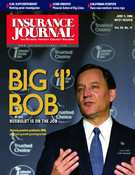The AccuWeather.com Hurricane Center in State College, Pa., led by Chief Forecaster Joe Bastardi, in its 2006 hurricane season forecast predicted an active hurricane season that could have major repercussions for the U.S. economy as well as the one in six Americans who live on the Eastern Seaboard or along the western Gulf of Mexico.
For the 2006 Hurricane Season — June 1 through Nov. 30 — Bastardi and his team are forecasting that six tropical cyclones will make landfall in the United States. Five of those land-falling storms are likely to be hurricanes, with three being major hurricanes of Category 3 or greater.
“The 2006 season will be a creeping threat,” Bastardi said. “Early in the season –June and July — the Texas Gulf Coast faces the highest likelihood of a hurricane strike, possibly putting Gulf energy production in the line of fire. As early as July, and through much of the rest of the season, the highest level of risk shifts to the Carolinas.
“From mid-August into early October, the window is open for hurricane strikes to spread northward to the more densely populated Northeast coast,” Bastardi predicted. “At the very end of the season, southern Florida also faces significant hurricane risk.”
Meanwhile, the the National Oceanic and Atmospheric Administration’s 2006 Atlantic hurricane season outlook released May 22 by the National Weather Service Climate Prediction Center forecasts 13 to 16 named storms, eight to 10 hurricanes and four to six major hurricanes.
NOAA’s report calls for an 80 percent chance for an above-normal hurricane season, a 15 percent chance of a near-normal season and a 5 percent chance of a below-normal season.
“There are few areas of the U.S. East Coast and Gulf of Mexico that will not be in
the bull’s eye at some point this season,” said Ken Reeves, AccuWeather’s director of Forecast Operations.
“Ironically, though, the region that was hammered the hardest last year–the central and eastern Gulf Coast — has one of the lower probabilities of receiving another major hurricane strike in 2006,” Reeves said.
“This is not to say that hard-hit New Orleans has nothing to worry about. Because the city’s defenses have been so compromised by Hurricane Katrina, even a glancing blow from a hurricane elsewhere could spell trouble for the city.”
Comparing 2006 with 2005
Following on the heels of 2005’s record-shattering hurricane season, 2006 will feature fewer storms, but will still be a season of above-average storm frequency. “There were 28 named storms last year, and we are expecting far fewer storms during this season. But keep in mind that it is not the number of storms that is significant, it is where they make landfall that sets the tone for the season,” Reeves said.
Last year, there were eight tropical cyclone landfalls in the U.S., including two separate strikes by Katrina as the storm crossed the Florida peninsula and then plowed into the central Gulf Coast. Four of those were major hurricanes — Category 3 or stronger — at one of their landfalls: Dennis, Katrina, Rita, and Wilma. The AccuWeather.com Hurricane Center forecasts six land-falling storms — five hurricanes and a tropical storm — this year, with three of the hurricanes being major upon landfall.
“With the exception of the southern tip of the Florida peninsula, almost all the damage wrought by last year’s storms in the U.S. occurred along the Gulf Coast,” Bernie Rayno, AccuWeather.com Hurricane Center meteorologist said. “In recent history, it is the Gulf coast and the East Coast from the Carolinas southward that have borne the brunt of U.S. hurricane strikes.
“Because of this, people may be unaware that portions of the Northeast coast have been severely damaged by major hurricanes in the past, and that there is a dramatically increased likelihood that over the next five years the Northeast could be hit by a major hurricane. This could be the year.”
Rayno noted that in general, the fast-moving nature of tropical cyclones in the Northeast will leave little time to protect property and lives. “Preparation is the key, since time is a perishable commodity when a hurricane is approaching the coast.”
“Because it has been decades since the Northeast was hit by a major hurricane, some residents in the Northeast have become complacent regarding the threat of a hurricane,” Bastardi explain-ed.
“It is for this reason that we have been warning of elevated danger from hurricanes in the Northeast since March, when we first identified that patterns that could lead to such an occurrence this year or in the near future,” Bastardi said.
Reeves said last year’s hurricane season had a tremendous impact on the U.S. economy, with the flooding of New Orleans, severe damage to many Gulf Coast communities, and the huge jump in energy prices that resulted when oil and natural gas production was disrupted.
“While the effects from last season will not be exactly repeated, there are many scenarios that could lead 2006 to be another costly season for the U.S. — another major strike in the western Gulf could again hamper energy production, or a hurricane along the heavily developed Northeast coast could lead to widespread property damage and put many lives at risk,” Reeves explained.
Topics Florida Catastrophe USA Natural Disasters Hurricane Aerospace
Was this article valuable?
Here are more articles you may enjoy.


 Two Montgomery Workers Charged with Insurance Fraud in Alabama
Two Montgomery Workers Charged with Insurance Fraud in Alabama  Investors Are Increasingly Interested in a Novel Type of Weather Insurance
Investors Are Increasingly Interested in a Novel Type of Weather Insurance  4,800 Claims Handled by Unlicensed Adjusters in Florida After Irma, Lawsuit Says
4,800 Claims Handled by Unlicensed Adjusters in Florida After Irma, Lawsuit Says  Rising Prices, Low Satisfaction Drive 49% of Customers to Shop For New Auto Insurance
Rising Prices, Low Satisfaction Drive 49% of Customers to Shop For New Auto Insurance 


